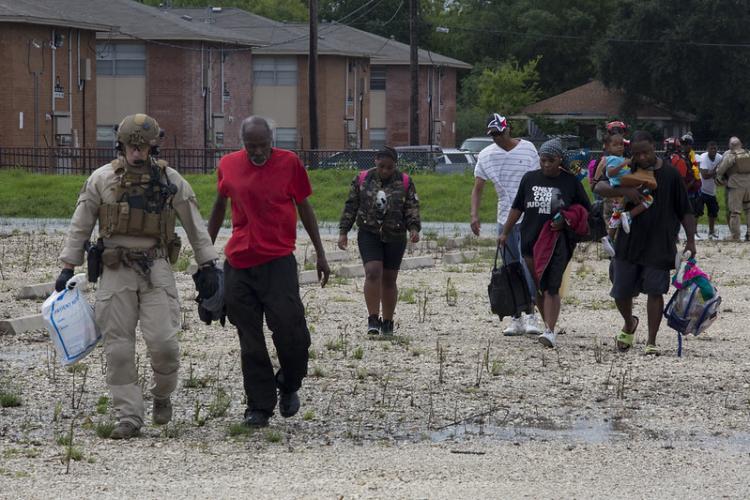Houston homeowners who were struggling financially before Hurricane Harvey were the most likely residents to end up in a worse financial position after the storm, suggests a new study by researchers from the Leeds School of Business at CU Boulder. While doing a deep dive into the financial data around Houston residents’ recovery, they found inequalities for lower-income residents in access to federal disaster assistance and loans, and a significant rise in their bankruptcy rates.
In the six months after the hurricane, they found a 30% increase in bankruptcy rates and a 35% bump in the share of household debt that is delinquent among financially fragile homeowners who flooded, but lived in areas that were not expected to. This was not the case for many other residents, including renters, and homeowners who were financially secure prior to the storm.
Residents in lower-income neighborhoods also commonly received less disaster assistance, even if they qualified for it.
“The more we dug into things, the more we realized that the wealthier you are, the more assistance you're getting. You're more likely to have insurance – and come out of the storm seemingly doing just fine. Compared to this other group of people that seems to really need help,” said Emily Gallagher, co-author of the paper and assistant professor in the Leeds School of Business.
“In allocating a limited pool of resources, the way we're handing it out seems to be distorted.”
Flood insurance, FEMA assistance, and access to low-interest loans are all part of disaster recovery, but there are restrictions on who can receive disaster funds and loans, how they can be used, and complicated paperwork to boot. This could be part of why lower-income residents struggled more significantly after Hurricane Harvey.
This is the first study of its kind to test for inequalities in access to FEMA grants.
Previous studies from Hurricane Katrina, which hit New Orleans in 2005, found that financial effects from hurricane flooding are mild and temporary – but these results clashed with anecdotal news reports which chronicled financial devastation for some residents.
The researchers wanted to know, could that also be true for Hurricane Harvey?
So they broke down the data from Hurricane Harvey, comparing multiple variables, including insurance coverage, home values, income, and location.
“When we started breaking things down along these lines, we saw there are actually massive effects on certain groups of people,” while other groups remain unscathed, said Gallagher.
Inequalities in assistance
Hurricane Harvey hit Houston in late August 2017 as a Category 4 storm, during one of the five worst hurricane seasons since 1960. Over the course of a week it dumped 51.88 inches on the Houston metropolitan area and submerged over a quarter of the city, causing $125 billion in damages – second only to Katrina.
But because 80% of flooding in Houston wasn’t within its mapped 100-year floodplain – and homeowners are only required to have flood insurance if their property falls within this boundary – only 17% of homes affected were covered by insurance. Fewer than 90,000 Texans made claims after the storm in a city of 2.3 million.
After flood insurance, there are two main assistance options for victims of flooding. Federal Emergency Management Association (FEMA) assistance and low-interest disaster loans from the Small Business Administration (SBA).
FEMA assistance is meant to be based on your disaster-related losses, and the researchers didn't expect to find any inequalities in access to FEMA assistance. Yet while an average of 29% of housing units on flooded blocks registered, they found that 80% were denied or not eligible for FEMA assistance.
When the damage exceeds 50% of a home’s value, you’re supposed to participate in a buyout program or sell it, instead of do repairs. The cheaper your house is, the more likely this is to happen. FEMA money is also earmarked for certain things. If you spend rental funds instead on transit, for example, you may be denied future assistance or be asked to return all funds, according to Gallagher.
Finally, paperwork issues that require legal aid are huge hurdles for some residents, preventing a resident from receiving assistance – even if they qualify for it.
The Small Business Administration also offers low-interest disaster loans that can be used to repair and replace property, homes and businesses. Eligibility, however, is based on one’s credit score and ability to repay, which were the most common reason loans were denied.

A Marine, a member of the Texas Highway Patrol and Texas State Guard escort a couple to higher ground, Houston, Texas, Aug. 31, 2017. (Credit: U.S. Department of Agriculture)
Policy implications
Some Houston residents, mainly renters and homeowners who were financially well-off prior to the storm, actually benefited in some ways – either from the disaster assistance money or being able to refinance their mortgage.
“While you have a lot of pain happening among certain groups, some groups actually benefit from these storms,” said Gallagher. “That surprised me.”
Present policy responses are therefore not mitigating the burden of natural disasters on financially fragile households, and unless addressed, this will continue to be an issue in areas affected by natural disasters in the future.
The researchers recommend that policymakers consider: making insurance premiums more affordable for low-income households; improving the accuracy of floodplain maps; addressing price discrimination for SBA loans; loosening restrictions on the use of FEMA funds, and expanding buyout programs.
Additional co-authors of this study include Stephen B. Billings and Lowell Ricketts of the Leeds School of Business at CU Boulder.
"assistance" - Google News
March 03, 2020 at 11:18PM
https://ift.tt/3aoDmtF
Flooding assistance left Houston residents on uneven ground - CU Boulder Today
"assistance" - Google News
https://ift.tt/2Ne4zX9
Shoes Man Tutorial
Pos News Update
Meme Update
Korean Entertainment News
Japan News Update
Bagikan Berita Ini
















0 Response to "Flooding assistance left Houston residents on uneven ground - CU Boulder Today"
Post a Comment